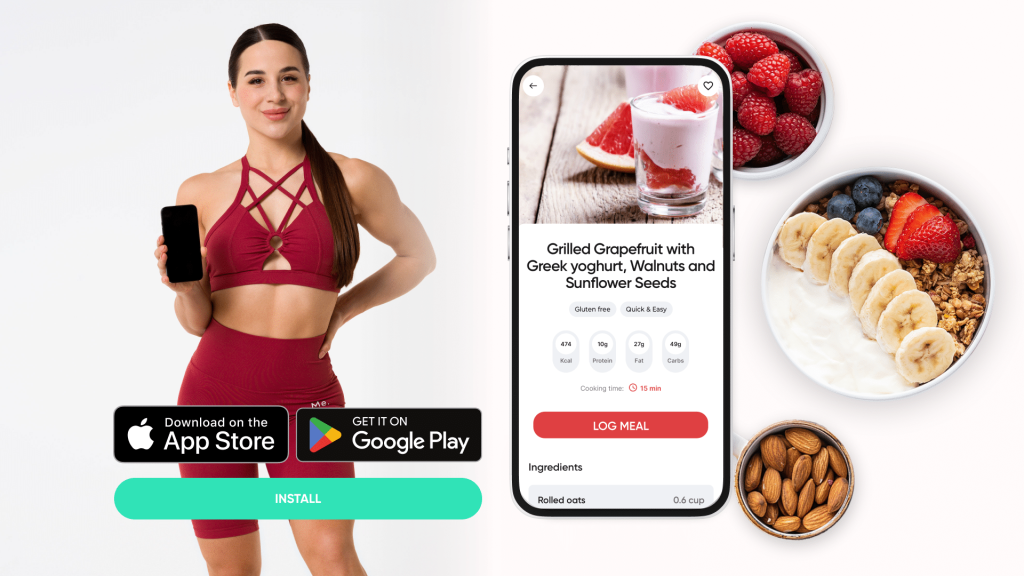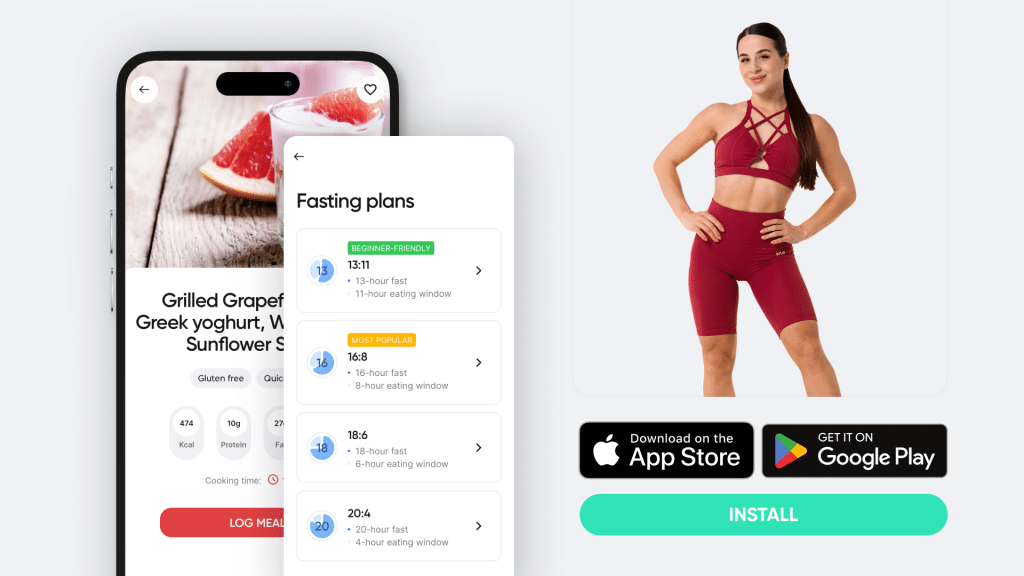Intermittent fasting has gained tremendous popularity in the past years. Fasting consists of a 12-40 hour-period during which an individual entirely or partially abstains from eating. Some studies demonstrate its connection to weight loss, improved heart health, and other potential health benefits. However, fasting is not for everyone. What’s more, it can bring potential drawbacks to your overall health as well. There are many types of fasting that will work well for both beginners and “fasting warriors”. In this article, we’ll disclose 6 types of fasting: their benefits and possible drawbacks.
What Is Intermittent Fasting?
Intermittent fasting is a period of time during the week when you don’t eat any food, or you significantly restrict your calories (10). In a nutshell, it’s not about what you eat, it’s more about when you eat. Of course, there are people who consume healthy balanced meals on non-fasting days or times but some individuals indulge in junk products instead which may negate some of the possible benefits of fasting.
You are allowed to drink water, unsweetened tea, and black coffee during fast, but solid food or calorie-containing drinks are generally off the table.
In one type of fasting for example, you might finish your breakfast at 9 AM Monday and don’t consume any food till 9 PM Tuesday. This will mean you’ve completed the 24-hour fast. Yet, 24-hour fasts and more are not advised for beginners.
There are multiple types of intermittent fasting which contain both benefits and downsides. Moreover, the effects of fasting depend on the individual and their habits during fasting.
What Are The Different Types Of Intermittent Fasting?
There are 6 major ways for intermittent fasting you can try today. Still, beginners should start with the first type as it won’t put them at a health risk.
Type#1 12-Hour Fast
This is the beginner-friendly type where a person needs to choose a suitable 12-hour fasting window every day (8).
If you don’t eat for 10-16 hours, your body will start to use its fat stores for energy (7).
This is a rather safe type of fasting because the fasting window is relatively small. Besides, most of this window can include sleeping time. An example of this type of fasting is simple: a person opts for the time to fast between 8 PM and 8 AM. This means you’ll need to finish your dinner at 8 PM and restrict yourself from eating till 8 AM the next day.
Read More: What Is Dry Fasting, And Is It Right For You?
Type#2 A 16 Hours-Fasting
16-hour fasting means fitting all your meals into an 8 hour window during the day. It’s also called a Leangains diet (8).
What does it mean? During the 16:8 diet, males consume no food for 16 hours each day, and females for 14 hours. Among different types of fasting this one is also good for beginners, especially someone who wants to move to a more advanced version from the 12-hour fast.
This intermittent fasting looks like this: a person finishes the evening meal at 8 PM and the next day they skip breakfast without eating until noon (or 10 a.m. if you are doing 14 hours of fasting).
However, you need to understand that skipping breakfast is not the best idea. Breakfast gives you a chance to get the essential vitamins and minerals at the beginning of the day, loading you up with energy to stay active. If you don’t get your fuel in the morning you’re more likely to overeat later and feel exhausted (2).
Hence, you need to talk to your healthcare provider before starting any fasting especially when it includes skipping breakfast.
Type #3 Fasting For 2 Days A Week
Also called a 5:2, it involves eating standard food for 5 days and drastically reducing calorie intake on the other 2 days (8).
Compared to different types of intermittent fasting this one is relatively safe because you get your ordinary calorie intake for almost a whole week and cut down calories in half for the 2 days. During these 2 fasting days, males usually consume 600 calories and females 500 calories, or about 25% of their normal energy needs.
You should separate the fasting days by consuming fewer calories on Monday and Thursday, for instance, and eating regularly on the other days. Please note that you should have at least 1 non-fasting day between fasting days. This type of fasting isn’t appropriate for everyone, so speak to your healthcare provider first.
Type #4. Alternate-Day Fasting
Alternate-day fasting means you fast every other day. Some people choose to avoid all food on fasting days, while others consume up to 500 calories or 25% of their energy needs (8).
One study shows that alternate-day fasting can be effective weight loss and heart health parameters in healthy and overweight adults. The results demonstrated that the alternate day fasting group lost an average of 5.2 kilograms (kg), or 11 pounds (lb), over a 12-week period.
This type of fasting is not suitable for beginners or people with medical conditions or those who take certain chronic medications. Therefore, speak to your healthcare provider before trying this type of fasting.
If you wish to free yourself from all the extra pounds that have been weighting you down for way too long, start using the BetterMe app and overhaul your entire life!
Type #5. A Weekly 24-Hour Fast
One of the most difficult types of fasting diets which involve a complete fast for 1 or 2 days a week. This means you don’t eat any food for 24 hours at a time. Some individuals fast from breakfast to breakfast or lunch to lunch (8).
You can drink water, tea, or other calorie-free beverages during the fasting period though to avoid dehydration.
On non-fasting days, you should stick to your regular eating routine. This type of intermittent fasting reduces a person’s total calorie intake but does not limit the specific foods the individual consumes (8).
Definitely not suitable for beginners, a 24-hour fast can be challenging even for advanced fasters as it may cause fatigue, headaches, or irritability. Of course, through time, these side effects might be less apparent due to your body adjustments.
People are advised to try a 12-hour or 16-hour fast before transitioning to the 24-hour fast, and as always, speak to your healthcare provider first.
Type #6 The Warrior Diet
One of the most challenging types of fasting for weight loss The Warrior Diet is an option for people who have tried all other kinds of intermittent fasting.
The Warrior Diet means eating very little, usually a few servings of raw fruit and vegetables, during a 20-hour fasting window, then eating one large meal at night (5). The eating window would not exceed 4 hours.
During the 4-hour eating phase, people should consume plenty of proteins, vegetables, and healthy fats. They need to include carbohydrates (8).
It might be challenging to stick to this kind of intermittent fasting in the long term. Besides, it’s hard for some individuals to consume large meals before getting to bed. This diet also involves little fiber consumption which isn’t ideal for gut health. . This is another more advanced and riskier fasting routine which you should speak to your healthcare provider about before attempting.
What Are 5 Benefits Of Intermittent Fasting?
The research on intermittent fasting effects on the human body is still in process. Some studies show the potential benefits of fasting on weight loss, reduced risk of chronic health conditions, and protection of the brain. Let’s dive into the 5 possible benefits of intermittent fasting more deeply:
- Weight loss reduction. Intermittent fasting is regarded by many as a good tool to lose weight. Intermittent fasting lowers insulin levels which may cause cells to release their glucose stores into energy (9). Besides, an individual consumes fewer calories during fasting time. However, a study in 2017 showed that intermittent fasting and typical calorie restriction brought similar weight loss results.
- Blood glucose control. Intermittent fasting can lower the level of blood glucose and insulin levels. Weight loss can also reduct the risk of type 2 diabetes. However, if you have diabetes or take medication to lower your blood sugar levels, you should talk to your doctor before attempting any kind of fasting or making any major changes to your diet.
- Improved heart health. The review in 2016 demonstrated the connection of intermittent fasting to improved measures of heart function in rats. This type of dieting might help reduce blood pressure, improve resting heart rate and heart rate variability, and reduce cholesterol and triglycerides, at least in animals.
- Brain protection. Studies have demonstrated the positive effects of intermittent fasting in animal models of Alzheimer’s and Parkinson’s disease, and stroke.
- A reducer risk of cancer. Obesity is a risk factor for certain types of cancer. That’s why losing weight via intermittent fasting or other types of diets may reduce this risk.
Read More: Non Fasting Your Way to Health: The Science Behind the Fasting Mimicking Diet
What Are The Negative Effects Of Fasting?
It is important to understand that fasting is not a diet for everyone. Some people need to avoid this diet or at least talk to their doctor before trying it out:
- pregnant or breastfeeding women
- people with diabetes or who take medication to lower their blood sugar
- people with chronic health conditions who take medications
- people with a history of eating disorders
- children and adolescents
Besides possible benefits, the negative effects of fasting can invade a person’s life. You should always talk to a healthcare provider before attempting a fasting regimen, and if you experience adverse effects, consider stopping.
Here are the possible pitfalls of intermittent dieting that can impair your wellness:
- The feeling of hunger (10). People often underestimate the necessity of nutritious breakfast, lunch, and dinner. When fasting, even the 12-hour fast can feel like too much for the beginner. The feeling of hunger could spoil your everyday routine with mood swings and general fatigue. This is especially applicable to diets that tell you to skip breakfast or dinner. By skipping breakfast you can become tired and less invigorated to move with your day, and skipping dinner can impair your sleep. Sleep impairment may contribute to depression, irritation, obesity, and other chronic health conditions (3).
- Headaches. Intermittent fasting dieting can lead to chronic pain in your head (10). Headaches can interfere with your mood and general mobility.
- Nausea. The feeling of nausea is a possible side effect of fasting. It occurs mostly due to dehydration. That’s why staying hydrated during fasting is necessary.
Yanking yourself back in shape has never been so easy with our game-changing fitness app! Start transforming your life with BetterMe!
Is Intermittent Fasting Good For Weight Loss?
You can lose weight with intermittent fasting. However, this is not always a reliable way to trim fat because once you get back to your regular eating you can regain your weight.
Additionally, some people indulge in junk food or overeat as compensation for not eating during one fasting window. This could negate some of the benefits of fasting. .
Plus, during fasting, it might be harder to do intensive physical activities. Note, losing weight by just eating less is not a good option.
That’s why weight loss via fasting should not be considered a primary idea. Individuals should follow healthy diets, get enough nutrients daily, and maintain an active lifestyle. Only in this way, your weight reduction will be healthy and sustainable.
The Bottom Line
Intermittent fasting is a type of dieting during which you avoid eating solid food and caloric beverages for 12 to 40 hours. In this article, we’ve disclosed the 6 types of fasting: their benefits and possible drawbacks.
Among the common types of fasting are: 12-hour, 16-hour fasting, 2 days-a-week fasting, alternate-day fasting, a weekly 24-hour fast, and warrior fasting.
Fasting may help you lose weight, protect the brain, and reduce the risk of some chronic illnesses. Besides potential benefits, fasting may lead to certain pitfalls like nausea, the feeling of hunger, insomnia, and fatigue.
Fasting is not recommended as a healthy choice to lose weight.
DISCLAIMER:
This article is intended for general informational purposes only and does not serve to address individual circumstances. It is not a substitute for professional advice or help and should not be relied on for making any kind of decision-making. Any action taken as a direct or indirect result of the information in this article is entirely at your own risk and is your sole responsibility.
BetterMe, its content staff, and its medical advisors accept no responsibility for inaccuracies, errors, misstatements, inconsistencies, or omissions and specifically disclaim any liability, loss or risk, personal, professional or otherwise, which may be incurred as a consequence, directly or indirectly, of the use and/or application of any content.
You should always seek the advice of your physician or other qualified health provider with any questions you may have regarding a medical condition or your specific situation. Never disregard professional medical advice or delay seeking it because of BetterMe content. If you suspect or think you may have a medical emergency, call your doctor.
SOURCES:
- Alternate day fasting for weight loss in normal weight and overweight subjects: a randomized controlled trial (2013, ncbi.nlm.nih.gov)
- Breakfast: Is It the Most Important Meal? (2021, webmd.com)
- Common Sleep Disorders (2020, clevelandclinic.org)
- Effect of Alternate-Day Fasting on Weight Loss, Weight Maintenance, and Cardioprotection Among Metabolically Healthy Obese Adults (2017, jamanetwork.com)
- Four Weeks of Time-Restricted Feeding Combined with Resistance Training Does Not Differentially Influence Measures of Body Composition, Muscle Performance, Resting Energy Expenditure, and Blood Biomarkers (2020, ncbi.nlm.nih.gov)
- Impact of intermittent fasting on health and disease processes (2016, ncbi.nlm.nih.gov)
- Intermittent fasting: the science of going without (2013, ncbi.nlm.nih.gov)
- Six ways to do intermittent fasting (2023, medicalnewstoday.com)
- What are the benefits of intermittent fasting? (2018, medicalnewstoday.com)
- What is intermittent fasting? Does it have health benefits? (2022, mayoclinic.org)











